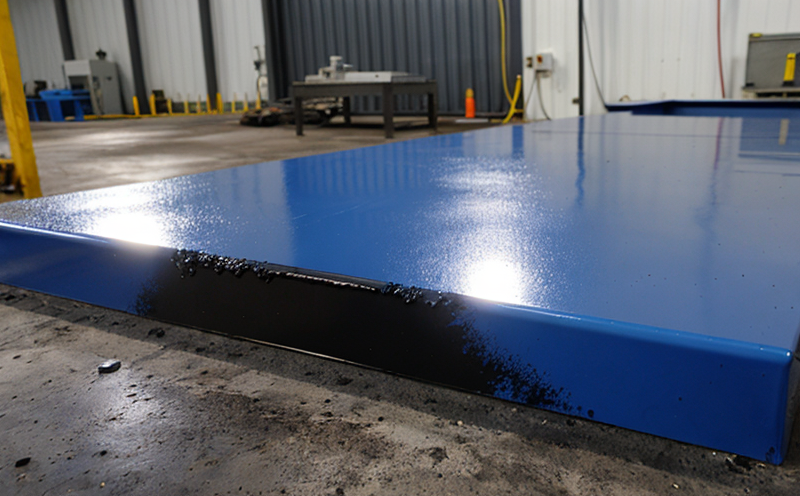ASTM B499 Coating Thickness by Magnetic Method
The ASTM B499 magnetic coating thickness testing method is a widely recognized technique used to measure the thickness of metallic coatings applied to ferrous substrates. This non-destructive test allows for rapid and accurate measurement without altering the integrity of the coated surface, making it an invaluable tool in quality assurance, research and development, and compliance management.
The ASTM B499 method is particularly advantageous when dealing with thin metal layers such as chromium, nickel, zinc, tin, or other similar coatings. The magnetic flux density between two ferrous surfaces can be measured using a calibrated instrument that applies a known magnetic field to the coated surface. By measuring this magnetic field and knowing the permeability of the coating material, the thickness can be calculated.
The test is conducted by placing the coated specimen on a suitable non-magnetic backing plate and positioning a calibrated magnetic coating thickness gauge over it. The instrument measures the change in magnetic flux density between the two ferrous surfaces before and after applying a known magnetic field. The difference provides the necessary information to calculate the coating thickness.
Specimen preparation is crucial for accurate results. The surface should be clean, free from contaminants, and free of any burrs or irregularities that could affect the measurement. The substrate must also be flat and uniform to ensure consistent readings across multiple measurements. For best results, specimens should not have been previously coated in a different process.
The ASTM B499 method is governed by international standards such as ISO 12330-1:2018, which provides additional details on the test procedure and acceptance criteria. The standard specifies that the coating thickness should be measured at various points across the specimen to ensure consistent results.
The magnetic coating thickness gauge used in this method is a precision instrument calibrated according to ISO standards. It consists of a calibrated coil system that generates a specific magnetic field. The instrument's output, which includes both direct and indirect measurements, provides an accurate reading of the coating thickness.
ASTM B499 is commonly employed in industries such as automotive manufacturing, aerospace, and electrical engineering where thin metallic coatings play a critical role in corrosion resistance and mechanical performance. In these sectors, ensuring that the correct amount of coating is applied can significantly impact product durability and reliability.
The method's non-destructive nature makes it particularly suitable for quality control during production processes. By using ASTM B499, manufacturers can monitor the application of coatings to ensure they meet specified thickness requirements without compromising the integrity of the coated surface. This ensures that products leave the factory with consistent performance and longevity.
For research and development purposes, ASTM B499 provides a reliable means of testing new coating formulations and processes. Researchers can use this method to optimize coating parameters, such as temperature, pressure, and time, to achieve the desired thickness without compromising on quality or efficiency.
Scope and Methodology
The ASTM B499 standard defines a magnetic coating thickness testing procedure for ferrous substrates. The scope includes the measurement of metallic coatings such as chromium, nickel, zinc, tin, and others applied to these surfaces using various methods.
- Calibrated Magnetic Coating Thickness Gauge
- Ferrous Substrate Specimens
- Clean and Flat Surface Preparation
- Magnetic Field Generation
- Thickness Calculation Using Permeability Data
The methodology involves placing the coated specimen on a non-magnetic backing plate, positioning the magnetic coating thickness gauge over it, and measuring the change in magnetic flux density between the two ferrous surfaces. The difference provides the necessary information to calculate the coating thickness.
Acceptance criteria specify that measurements should be taken at multiple points across each specimen to ensure consistent results. The standard also outlines permissible tolerances for coating thickness deviations from specified values, which are typically ±10% depending on industry standards and specific application requirements.
Competitive Advantage and Market Impact
The ability to accurately measure coating thickness using the ASTM B499 method provides significant competitive advantages in several key areas:
- Quality Assurance: Ensures that products consistently meet specified standards, enhancing customer trust and satisfaction.
- Efficiency: Non-destructive testing allows for rapid quality checks during production processes, reducing downtime and increasing productivity.
- Innovation: Researchers can use this method to optimize coating parameters, leading to the development of more effective and durable products.
In the highly competitive global market, companies that utilize ASTM B499 for their quality control processes are better positioned to meet regulatory requirements and customer expectations. This leads to enhanced brand reputation and increased market share.
For procurement teams, ensuring compliance with industry standards such as ASTM B499 is essential. By selecting suppliers who use this method, organizations can ensure the reliability and performance of their products. In turn, this contributes to a positive market impact by fostering trust among consumers and stakeholders.





